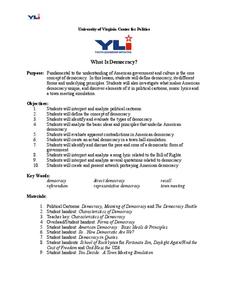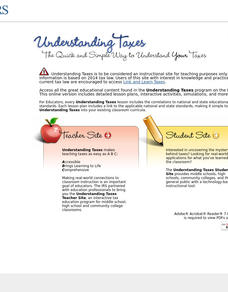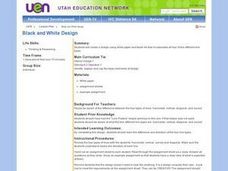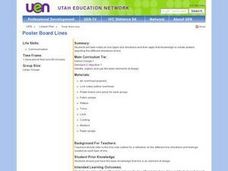Curated OER
Building from the Ground Up
Third graders research the interdependence of communities within different countries. In this community lesson, 3rd graders create a new community from a preselected country in South America. Students use the findings from their research...
Curated OER
"A Costly Prosperity", South Carolina during World War II
Eleventh graders study the history of South Carolina during World War II. In this American History lesson, 11th graders analyze the economic growth of this state through primary sources. Students interpret many different...
Curated OER
Keep Your Eye on the Sky
Students examine the different types of satellites, cloud formations and weather patterns. In this weather lesson students use the Internet to research weather satellites, then write an article and create graphs.
Curated OER
Understanding the Great Depression Through Film
Eleventh graders consider the role that government should play in economics. In this Great Depression activity, 11th graders watch the film Cinderella Man and then complete a packet of worksheets to help them analyze the themes of...
Curated OER
Diversity of Life
Students identify the difference between eukaryote and prokaryotes and examine the structure of bacteria. In this bacteria lesson students examine the different ways that bacteria are classified through an activity.
Curated OER
Inflation and Money
Learners define money in terms of its functions and refer back to discussion of markets and the role of money in reducing transaction costs. They give examples of types of money.
Curated OER
What is Democracy?
Students examine civic duties. In this citizenship lesson, students play an online game that requires them to consider the needs of their community. Students campaign for the issue they choose in the game.
Curated OER
Taxes in U.S. History: Evolution of Taxation in the Constitution
Students receive an overview of the role and purpose of taxes in American history. They identify different types of taxes implemented by the US government and explain the origin of the federal income tax.
Curated OER
Black and White Design
Students are introduced to the four different types of lines. After explaining the basic elements of design, they create their own artwork using white paper and black ink incorporating the different types of lines. To end the...
IBM
The Human Body
Every moment, the systems in your body are working together to keep you breathing, standing, and thinking. Elementary schoolers explore the human body and its systems with an impressive, 15-page lesson plan that should leave your...
Curated OER
The Cost of Community Services
Students identify the types of services provided to citizens by local government and evaluate tax revenue versus the costs of delivering these services to developments. They evaluate the advantages of spatial relations to delivery of...
Curated OER
How Did That Get There?
High schoolers evaluate the role of government in addressing land use and other environmental issues. They analyze the powers, responsibilities, and limitations of elected and appointed officials in the national legislative, executive,...
Curated OER
Lesson Plan on Why Nations Trade
Twelfth graders examine the difference between imports and exports and the types of decisions made by governments when it comes to trading. They identify the key players and characteristics of international trade. They also discuss...
Curated OER
Interior Design: Poster Board Lines
Observe different types of lines and apply skills to create posters demonstrating line directions. Discern the four different types of lines and the ambience each creates in a room. In groups, explain each line poster.
Curated OER
Poster Board Lines
Students take notes on line types and directions and then apply that knowledge to create posters depicting the different directions of line. They differentiate between the four different directions of line and the feelings that each...
Curated OER
Wallpaper Pattern
Students identify, explain and use the basic elements of design. They find examples of the four different types of patterns by using wallpaper as their medium. They identify the four different types of pattern and find correct...
Curated OER
But They Never Told Me!
Students investigate how government legislates the protection of citizens from natural disasters such as earthquakes in California. They read the Alquist-Priolo Special Studies Act and debate its pros and cons. They discuss how much...
Curated OER
Foundation, Nonprofit, All Matter to Me
Students examine different types of foundations and non-for-profit organizations. They identify the focus of the different organizations. They finally relate the beginning of certain foundations or non-for-profit organizations with...
Curated OER
Hybrid Automobiles
Students explain the basic principles of gasoline engines as propulsion for vehicles. They cite reasons why alternatives for gasoline engines are being considered and explain differences between a motor and an engine.
Curated OER
Laws Promoting Healthy Aging: A Comparison of Japan and the United States Lesson Plan
High schoolers compare and contrast legislation passed in Japan and the United States in regards to the elderly. Using the Internet, they research how the government has put programs into place to improve the health of older citizens....
Curated OER
Diet: Cereal Grains and Nutrition
Students identify the nutritional value of various cereal grains. Without adding sugar, they cook with grains and compare the taste to cereal containing sugar. In addition, students complete worksheets about the different grains,...
Curated OER
Follow that Cheese
Students research types of cheeses. In this cheese types lesson, students research the origin of cheese and then investigate the area of origin. Students share their reports. Students have a cheese tasting celebration as a culminating...
Curated OER
Houghton Mifflin Social Studies/Chapter 13, Lesson 2 California Fights Smog (pp. 296-300)
Third graders look into certain environmental problems. The governmental branches are investigated and how government takes care to solve problems of the environment.

























